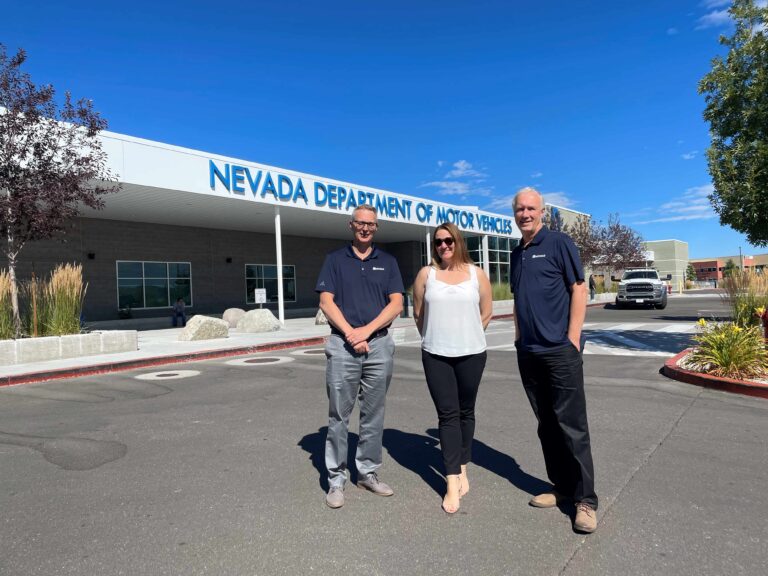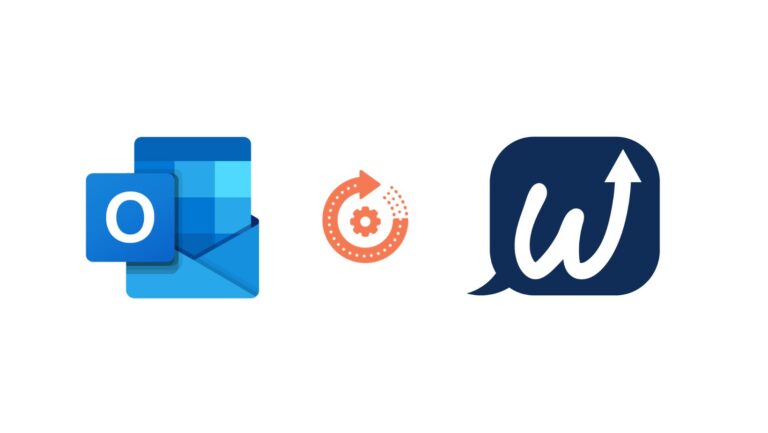5 lessons for building a successful one-stop student services center
Five Ways WaitWell is the perfect digital companion at higher ed one-stops for student services
At the 2023 Annual Institute for Student Services Professionals (ISSP) conference, WaitWell had the privilege of sitting down with leaders from two prominent universities: Jennifer Vick, the Operations Coordinator for 1Diefendorf at the University at Buffalo, and Sejal Shah, the Senior Manager at the University of Texas at Austin One-Stop. Alongside them was Shannon Vander Meulen, the CMO and one of the Co-Founders of WaitWell, the technology that has helped revolutionize their respective One-Stop centers.
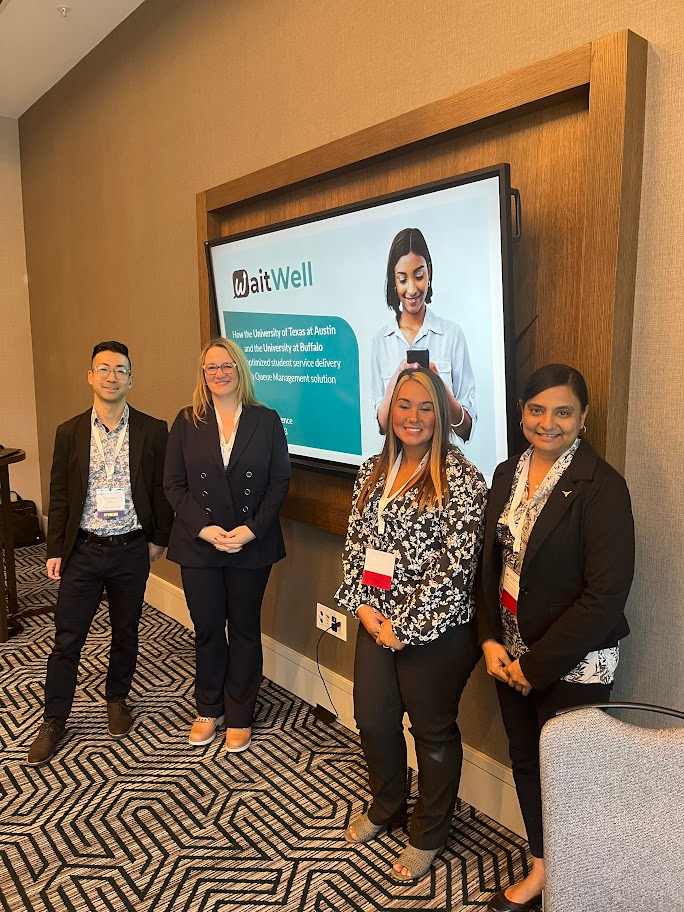
In higher education, a one-stop shop serves as a centralized and comprehensive resource center, where students can access many services and support functions under a single roof. These services often encompass financial aid, academic advising, registration, and various administrative processes. The one-stop shop model aims to simplify and streamline the student experience, offering a convenient hub that minimizes bureaucratic hurdles and enhances overall efficiency.
Technology plays a pivotal role in the success of a one-stop shop in higher education. Its importance lies in its capacity to facilitate seamless communication, enhance accessibility, and optimize service delivery. Digital platforms, such as WaitWell, revolutionize this one-stop experience for students and staff. They enable efficient visitor management, streamline appointment scheduling, and provide detailed ticket histories, ensuring personalized and timely student assistance.
1. Reducing student wait times with smart queue management
An effective queue management system addresses the challenge of long queues and significantly shapes the overall experience at a one-stop student service center through tailored communication and personalized service delivery. Reducing the wait times ensures that students can spend more time actively engaging with the support services they need, fostering a more efficient and responsive service model.
Jennifer Vick from the University at Buffalo reports that since implementing WaitWell, the typical four-hour lineup during the start of the academic year, where students queue up for their Student ID cards, has been effectively eliminated.
“Students could remotely join the app queue and return when they got a text message telling them it was their turn. This has been a huge success for both of our campuses, and we are forever grateful to WaitWell for giving us that. We’ve only been utilizing WaitWell since July, and we have already seen great results.” – Jennifer Vick, Operations Coordinator for 1Diefendorf, the University at Buffalo
Before adopting WaitWell, the University at Buffalo was experiencing something called the “UB Bounce.” This referred to instances where students either initially visited one campus but changed locations due to overwhelming crowds, or had to be redirected to another facility because the first destination could not provide the required service.
Now, Jennifer can utilize the real-time dashboard on WaitWell, enabling her to view analytics from other campuses. This allows her to anticipate the potential impact at her location, and if her campus is less busy, she can deploy staff to assist a busier one-stop location.
2. Adapt to student needs and optimize resources with a flexible appointment system
Efficient appointment scheduling is paramount for optimizing the service model of one-stop shops in universities. These centralized hubs significantly benefit from streamlined and personalized assistance made possible through a well-structured scheduling system. Overcoming the limitations of traditional methods, a flexible appointment system minimizes conflicts, reduces wait times, and ensures staff availability to address individual student concerns. This approach not only enhances operational efficiency but also fosters a student-centered environment by accommodating the unique demands and preferences of digital-first students, ultimately contributing to a positive and supportive university experience.
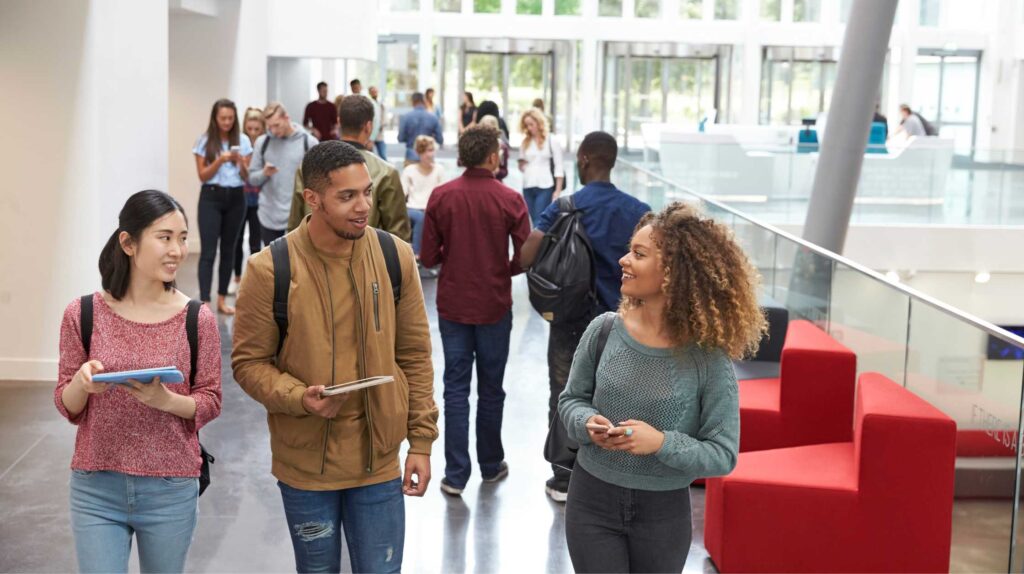
WaitWell empowers students with the flexibility to book, cancel, and modify appointments at their convenience, even beyond regular hours. Recognizing the preference for online booking over traditional calls, this user-friendly approach ensures that students are more inclined to schedule appointments, eliminating potential barriers and encouraging them to seek assistance without hesitation from the student services office.
In addition to its user-friendly features, WaitWell goes the extra mile to meet the evolving needs of students by offering seamless virtual appointments. With integrated Google, Microsoft Teams, and Zoom functionalities, students can connect with service providers from the comfort of their own space.
This not only enhances accessibility but also accommodates busy schedules, making support services more convenient than ever. The integration of Google, Teams, and Zoom further reflects WaitWell’s commitment to utilizing technology to ensure a smooth and efficient appointment experience for both students and service providers alike.
Sejal Shah, the Senior Manager at the University of Texas at Austin One-Stop says that all of their locations campus use WaitWell differently. For instance, the passport office exclusively utilizes appointments, eliminating walk-ins. Meanwhile, other departments leverage WaitWell for both virtual and in-person walk-ins. This diversity empowers staff with flexible scheduling options, providing students with choices for either in-person or virtual services. The integrated functionalities of Zoom and Teams add an extra layer of adaptability, enabling various campus offices to customize their usage of WaitWell according to their specific requirements.
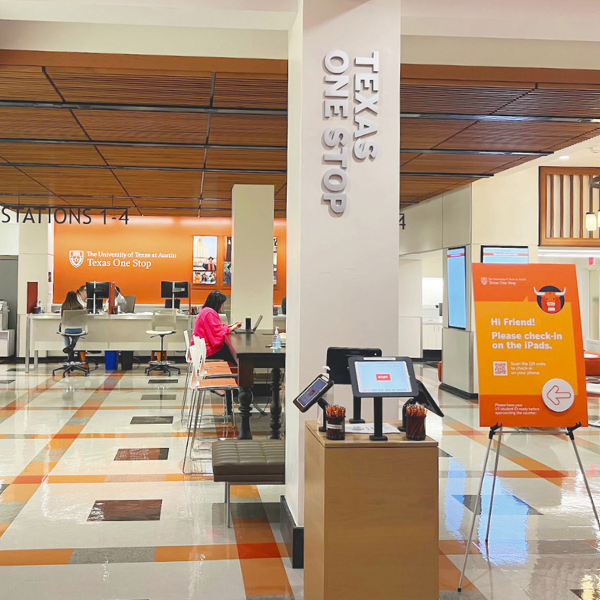
“Our end goal is to make sure students are self-sufficient and enable our staff to be more productive, and WaitWell does that for us.” – Sejal Shah, Senior Manager, University of Texas at Austin One-Stop
3. Streamlined and customized communication to reduce staff and student confusion
Customized communication is a cornerstone for fostering efficiency, satisfaction, and a student-centric environment. These centralized hubs, catering to multifaceted student needs, demand a communication strategy that not only simplifies complex processes but also addresses the unique preferences of individual students.
Clear and concise communication ensures that students easily understand procedures, deadlines, and available resources, reducing confusion and potential delays in seeking assistance. It establishes a foundation of transparency, allowing students to navigate the system with confidence and certainty. Offering personalized channels on their mobile devices, such as email, text messages, or app notifications, caters to the varied communication styles of the student body. This tailored approach enhances engagement, making students feel more connected and supported throughout their academic journey. As Sejal said, todays students expect clear and honest communication.
“One of the biggest pieces of feedback that we got about our service delivery is that your students want to trust you. If you say you will have something done in 10 days, they want it done in 10 days because they want to believe and trust you. This can be done through honest and clear communication” – Sejal Shah, Senior Manager, University of Texas at Austin One-Stop
WaitWell goes above and beyond in reinforcing trust among UT Austin students by offering a seamless experience that revolves around transparent communication and precise wait time information at every step of their academic journey. The platform’s commitment to providing real-time updates on wait times ensures that students are well-informed and can plan their engagements effectively. This not only streamlines their experience but also demonstrates a dedication to transparency, aligning with the expectations outlined by Sejal. By integrating WaitWell into the service delivery model, UT Austin’s one-stop shop exemplifies a student-centric approach that not only meets but exceeds the trust expectations of today’s students, fostering positive and reliable interaction between students and the institution.
In addition to fostering efficiency and satisfaction, clear and concise communication is pivotal in establishing trust—a critical element in the student-centric environment of one-stop shops. The importance of timely and accurate information cannot be overstated, as it empowers students to navigate procedures, meet deadlines, and access available resources with confidence. This transparent foundation is further strengthened by the integration of personalized communication channels on mobile devices, aligning with the diverse communication styles prevalent among today’s students.

Sejal Shah’s insight shows the significance of trust in service delivery, emphasizing that students not only desire but expect clear and honest communication. Aligning with this expectation, customized communication strategies become not only a practical necessity but also a key driver in building and maintaining trust between students and one-stop shops. By adhering to commitments and delivering on promises through transparent communication, one-stop shops can instill confidence, promote engagement, and ultimately contribute to the overall success and satisfaction of the student community.
4. Detailed interaction history at-a-glance
Maintaining a system to track student data, including past visits, assisting staff members, and service wait times is crucial. This capability enables a seamless continuation of service by allowing staff members to pick up right where they left off. By having this information readily available, staff can provide a more personalized and efficient experience, ensuring that each student interaction is informed by their history and preferences. This approach not only enhances the overall quality of service but also contributes to a more streamlined and customer-centric process within an institution.
Sejal and the Texas One-Stop team value the advantages of ticket history, as it removes the necessity to navigate across various systems to access both student information and their previous visits. This feature is especially advantageous for remote staff members, enabling them to understand each student’s assistance requirements without the need for physical presence. The seamless access to historical data contributes to a more efficient and flexible work environment, aligning with the team’s commitment to providing effective and accessible support to students, regardless of their location.
“We use WaitWell ticket history because it’s so convenient. We can see if the student is a repeat student and why and when they came in each time so we can adjust our approach. The information is just right there for the staff to see at at-a-glance.”- Sejal Shah, Senior Manager, University of Texas at Austin One-Stop
At the University at Buffalo, Jennifer leverages ticket history for troubleshooting. When a student visits their one-stop multiple times, the staff can review what might have been overlooked during the initial interaction. Furthermore, in the event of service issues, upper management can access the student’s visit details to understand what transpired and determine how to assist them moving forward. This utilization of ticket history not only enhances problem-solving efficiency but also ensures a more informed and supportive approach to addressing students’ needs and concerns.
5. Understand one-stop activities better with detailed reports and analytics
Reports and analytics, whether they be real-time or historical, act as a strategic compass that guides operational enhancements and customer satisfaction. These insights provide a comprehensive overview of service performance, enabling administrators and staff to identify trends, strengths, and areas for improvement. The data-driven approach offered by WaitWell allows for a comprehensive understanding of student engagement, helping to refine service strategies and allocate resources effectively.
Reports and analytics become instrumental in optimizing service delivery by shedding light on peak hours, popular service types, and potential bottlenecks. This information empowers one-stop hubs to streamline workflows, reduce wait times, and enhance overall operational efficiency. Administrators can identify patterns in student behavior, guaranteeing the delivery of timely and personalized assistance.
They are also pivotal for proactive decision-making. By assessing wait times, service utilization, and staff performance, administrators can implement targeted improvements, ensuring a seamless and responsive service experience for students. The ability to generate detailed reports facilitates communication with stakeholders, showcasing the impact of the one-stop service and supporting data-driven strategies for continuous enhancement.
The leadership team in particular at Texas One-Stop loves the reporting. They utilize it every day to see how many students are waiting in the queue and how long they have been waiting.

“Our leadership team and our staff who manage the front lines really like how you can see how many students are waiting in the queue and how many staff are serving students at any moment with the dashboard.” – Sejal Shah, Senior Manager, University of Texas at Austin One-Stop
Jennifer at the University at Buffalo sees value in the reporting and analytics features, with a particular emphasis on the location summary report. This report, generated weekly, compiles essential service metrics like average wait times and average service times. Its automated delivery to management via email allows for easy reflection on the week’s activities, offering insights into performance and trends. This feature streamlines the process of reviewing key metrics, facilitating a proactive approach to addressing challenges and optimizing service efficiency at the University at Buffalo.
The integration of WaitWell into the operational framework of university one-stop service centers emerges as a transformative solution, empowering institutions to redefine the student experience. Through its user-friendly interface, flexible appointment scheduling, and comprehensive reporting and analytics, WaitWell addresses the evolving needs of both students and administrative teams. The platform’s commitment to transparency, demonstrated through detailed ticket histories and real-time wait time updates, fosters trust and enhances communication.
Furthermore, the personalized features, such as tailored communication channels and insightful reporting tools, underscore WaitWell’s dedication to meeting students where they are, both in terms of technology and individual preferences.
The firsthand experiences shared by experts such as Sejal Shah and Jennifer from the University at Buffalo show how WaitWell makes a difference in one-stops by streamlining operations, enhancing efficiency, and ultimately advancing toward a service model centered around the needs of students
As educational institutions continue to navigate the complexities of modern student service, WaitWell stands out as a comprehensive solution that exceeds the expectations of a tech-savvy and diverse student population. Its adaptability, ease of use, and data-driven insights position it as a key ally in shaping a positive, responsive, and efficient one-stop service experience for both students and staff.






